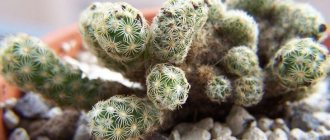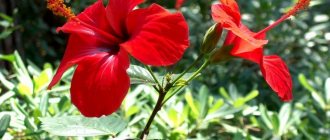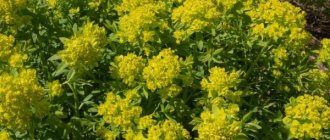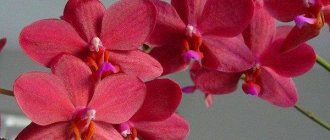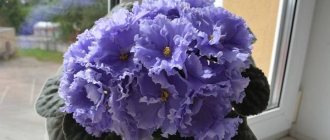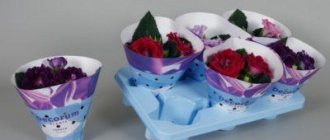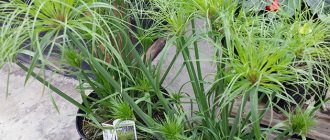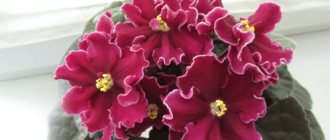- October 30, 2018
- Flowers
- ROME.
There are a huge number of different varieties and hybrids in the begonia genus. West Africa is considered to be the birthplace of the plant. From there, begonias spread to America, Asia, and Indochina. Accordingly, subtropical and tropical climates are considered native to this plant species. The flower received its name in honor of Governor M. Begon, who organized an expedition to collect plants in the Antilles. It was since then that people learned about begonia. All six plant species found during this expedition were named after Michel Begon.
Obtaining new varieties
The plant came to Russia during the time of Peter I. It was brought from Holland along with other types of tropical plants. New varieties of begonia plants began to be intensively developed only in the middle of the 19th century, after new species were found - large-flowered and tuberous begonia.
Many new varieties have been bred in Belgium from the tuberous variety. They are full of colors and have different flower shapes. Tuberous species can be planted in the garden, while others can only be grown indoors.
The leaves of all types of flowers are asymmetrical and have jagged edges. Their colors are varied: there are varieties with monochromatic leaves, and there are those that have up to four or more shades. Flowers can be one-color or two-color. They are painted in a variety of shades. The sepals are bright, uneven, and after flowering the capsule ripens.
Those who grow plants know almost everything about begonia and how to reproduce it. New specimens can be obtained by seeds, leaf fragments, cuttings, shoots, tuber division, and rooting of adventitious buds.
Begonia: varieties, types
The genus Begonia includes about 1,600 species, but only 125 of them and all kinds of hybrids are used for decorative purposes. There is still no general system for classifying the plant, and foreign and Russian-language sources provide completely different classification options.
Professor V.V. Vorontsov, Doctor of Agricultural Sciences, identified the following conventional types of begonias:
- decorative deciduous begonias;
- bush begonias;
- tuberous begonias;
- beautiful flowering begonias.
Begonias deciduous (decorative deciduous)
Deciduous begonia does not have a common above-ground stem, and long, hairy leaves grow immediately from a branched root. This type of begonia amazes with the beauty of its leaves, which have a variety of shapes and colors. Leaf color can be green, red, silver, yellow, white or brown. Leaves can be either plain or multi-colored, with various spots and edges.
The most famous types and varieties of decorative deciduous begonias:
- Royal Begonia (Rex Begonia) (lat. Begonia rex) is a hybrid species with round or oval leaves 30 cm long with jagged edges. Their color varies from brown-pink to purple and violet. Begonia leaves are decorated with a white, silver or green border.
- Begonia Metallica (metallic) (lat. Begonia metallica) with small (10-15 cm long) olive-green, pubescent, ovoid leaves, the edges of which are cut with denticles. The upper part of the leaves of this type of begonia is covered with metallic pollen.
- Tiger begonia (Bauer's begonia) (lat. Begonia tiger paws, Begonia bowerae) with medium-sized green, serrated, heart-shaped leaves and an animalistic pattern in brown or dark gray.
- Mason's begonia (lat. Begonia masoniana) is a deciduous begonia that grows in New Guinea and is of particular value due to its unusual leaf pattern, reminiscent of brown Maltese crosses. The length of the leaves can reach 20 cm; the leaves of old begonias acquire a characteristic silvery tint. The height of the plant usually does not exceed 20-35 cm. The flowers are medium-sized, light beige in color.
- Begonia Cleopatra (lat. Begonia cleopatra) is a species distinguished by very decorative leaves, similar to maple leaves. The outer side of the leaves is colored intense green or olive; the leaves below can be burgundy or bright red. A distinctive feature of this type of begonia is the elongated, fleshy leaf cuttings, densely covered with white or gray hairs. The height of the bush usually does not exceed 30 cm, in rare cases it reaches 50 cm. Cleopatra begonia blooms in January and February, then the plant throws out thin peduncles strewn with groups of white and pink flowers.
- Collar begonia , also known as cuff begonia (lat. Begonia manicata) is a plant native to Mexico with a creeping stem and large fleecy light green leaves up to 30 cm in diameter, growing on long cuttings. Begonia received its name due to the thick cuff of red fibers bordering the stalk just under the leaf. In winter, adult plants form about 5 flower stalks up to 60 cm long, decorated with an elegant brush of bright pink flowers.
- Red-leaved begonia (lat. Begonia erythrophylla) is a South American species that is distinguished by short fleshy stems and glossy rounded leaves, green on top and intense red below. The maximum height of a begonia bush is 35-40 cm. In mid-summer it blooms with medium-sized pinkish flowers.
Begonia bush
Bush begonia has densely growing, geniculate, branched stems that look like bamboo shoots. The plant is a bush with numerous side shoots. The leaves have a variety of shapes and colors. The flowers are beautiful and graceful. The root is thick and fleshy, not divided into parts. Bush begonia blooms all year round. Begonia varieties come in both annual and perennial varieties. The height of the bushes is from 10 cm to 2 meters.
Among the representatives of this variety of begonias, the following are very popular:
- Coral begonia (lat. Begonia corallina) with erect bare stems reaching a length of 0.5-1 m. The front side of the oblong, ovoid leaves is dark green in color with silver speckles, and the back is brownish-red. The dense inflorescences of coral begonia consist of simple small flowers.
- Fuchsia begonia (lat. Begonia fuchsioides) with highly branching tall stems (up to 1 m) and large oval green leaves with a glossy surface. Rare hanging flowers of fuchsia begonia are painted in all shades of red.
Begonia tuberous
Tuberous begonia has a tuberous rhizome, fleshy translucent stems up to 80 cm high, simple or double flowers similar to roses, carnations, camellias or peonies. Flowers can be either small or large, single or in inflorescences, with a diameter of 3 to 20 cm. Plants are herbaceous, shrubby or ampelous. The leaves are heart-shaped, they can be either fluffy-matte or glossy, flat or corrugated. The color of the leaves contains all shades of green: from light to dark. The flowering of tuberous begonia is long and very beautiful, lasting from May to October.
Popular varieties of erect tuberous begonias:
- Begonia Picotee Harlequin (lat. Picotee Arlequin) is a semi-spreading plant no more than 0.25 m high with large (up to 12 cm in diameter) double yellow flowers that have a bright red border. The leaves are green, jagged.
- Begonia Bouton de Rose (lat. Bouton de rose) is a low compact bush with double flowers, similar to a rose, reaching 18 cm in size. Petals are white or pale pink. The leaves of the begonia variety Bud de Rose are green, large, with a wavy edge.
- Begonia Duck Red (lat. Dark red) is a low-growing bush with semi-spreading stems and large, finely toothed green leaves. The double dark red flowers of this variety of begonias do not exceed 10 cm in diameter and resemble a peony.
- Begonia Crispa marginata (lat. Crispa marginata) is a spreading plant with green leaves with a purple edge. Begonia height is 15 cm. The flower is delicate yellow or white with a red border and curly edges.
Ampelous varieties of tuberous begonia:
- Begonia ampelous is a tuberous variety of begonia with long, cascading stems covered in colorful flowers on long flower shoots. The flowering period lasts from early spring to late autumn. One of the most popular varietal groups of hanging begonia is the “Chanson” series, which amazes with its variety of colors and shades.
- Bolivian begonia (lat. Begonia boliviensis) is a type of ampelous begonia, the shoots of which first grow upward, and upon reaching a height of 30 cm, elegantly fall down in the form of a multi-tiered flower cascade.
Begonia blooming (beautifully flowering, decorative flowering)
This group includes begonias with very beautiful simple and double flowers of various colors.
The most popular are the following types and varieties of begonias:
- Ever-flowering begonia (lat. Begonia semperflorens) unites a large group of varieties that have the remarkable property of blooming all summer, regardless of weather conditions.
- Begonia Elatior (lat. Begonia elatior) is a hybrid variety from England, obtained by crossing tuberous begonia and socotrans begonia. Due to the ability of year-round flowering, this plant received the name winter begonia (lat. Begonia hiemalis). It is a compact bush, about 40 cm high, with a thick stem and bright, glossy leaves about 8 cm long, shaped like an asymmetrical heart with jagged edges. Numerous simple or double flowers form multi-tiered inflorescences growing on long stalks.
- Begonia Gloire de Lorraine (lat. Begonia Gloire de Lorraine), like begonia Elatior, belongs to winter-flowering varieties. It was developed in France in 1891 by crossing Begonia socotrana and Begonia dregei. This rather spreading, low plant is distinguished by rounded glossy leaves of light green color with a red spot at the base. Begonia begins to bloom in the fall and continues throughout the winter. The simple flowers form drooping clusters of pink.
Varieties of flowers
The diversity of domestic begonias is so great that connoisseurs of these plants still cannot come to a unified system for classifying species, but have developed many different criteria. Thus, all plants are divided according to the type of stem, decorative foliage, flowers, growing method, and type of root system.
Knowing everything about begonia, you can get an idea of how to care for the plant. Based on this, it is worth understanding the principles of classification. Most often, color division occurs according to the following principles:
- Application and decorative effect. According to this principle, plants are divided into decorative-flowering and decorative-deciduous.
- Root system. There are tuberous plants with rhizomes and a superficial root system.
- Type of growth, shoots. There are bushy, drooping and lodging begonias.
Description
Begonia flowers are unisexual and there are both male and female flowers on the same plant. First, the male begonia flowers open; they are either simple staminate or double. The doubleness of flowers can reach such a degree when the stamens are transformed into something like a petal and the flower is sterile. Then the female flowers bloom, they are always simple and smaller in size. Often such flowers are removed to prevent the formation of seed pods. When fruits form, begonia devotes all its energy to their ripening and quickly becomes exhausted, stopping flowering.
Begonia flowers are velvety, mostly in warm colors:
- creamy white;
- beige;
- yellow;
- orange;
- scarlet.
Begonias come in different sizes. Their flowers can be very small or huge:
- Cross spider
- Reptiles
- 72 facts about plants
- Animals of Siberia
- 35 facts about giraffes
- Animals of Crimea
- Giant (gigantea) with flowers up to 20 cm in diameter.
- Large-flowered (grandiflora) flowers 10–14 cm.
- Abundantly flowering (floribunda) 8–10 cm.
- Multi-flowered (multiflora) 5–7 cm.
Begonia leaves are usually asymmetrical in shape, resembling elephant ears or a heart with unequal halves:
- with rounded edges;
- jagged edges;
- wavy terry edges.
There are species with lotus-shaped, maple-shaped, star-shaped carved leaf plates lying in the same plane or twisted into a double spiral. The color of the leaves is no less varied than the color of the flowers.
Plain colored:
- light green with a bright pink underside showing through in the light;
- rich green;
- dark olive;
- almost black velvety.
There are species with a contrasting purple border around the perimeter of the leaf or a light stripe running down the middle of the leaf blade.
In variegated begonia species, there is a combination of up to 4–5 colors on one leaf:
- silvery white;
- green;
- pink;
- purple;
- brown.
On leaf blades there is often a pattern in the form of a white or lemon mesh of veins. In spotted species of begonias, the leaves are decorated with splashed spots of silver, pink, and purple.
Based on the structure of the stem, the genus of begonias is divided into groups:
- Reed with tall, straight, knotty shoots.
- Shrub species (shtraby) form low branched shrubs strewn with flowers.
- Caudex (tuberoses), in the lower part of the stem of which a characteristic thickening is formed. These species are able to store water in the fleshy stem and branches.
- Climbing species with flexible creeping stems. Begonia roots also vary in shape, depending on the type of flower.
They can be:
- Tuberous, when fragile translucent shoots grow directly from the tuber.
- Rhizomatous, creeping along the ground.
- Fibrous, in begonias with a superficial root system.
Classifications by V.V. Vorontsov, European
In his work, Professor V.V. Vorontsev told everything about begonia and gave a classification of plants, which is most often used by gardeners. So, in his opinion, all varieties should be divided into:
- tuberous;
- decorative deciduous;
- decorative flowering;
- shrubby.
There is a European system for dividing species. According to it, plants are classified into scrubs, ever-flowering, tuberous, ampelous, caudex, rhizomatous, royal, and cane.
The history of the origin of the flower and its name
There are more than 1000 varieties of begonia in nature. The largest number of species is found in South America, followed by Asia (India, Himalayas, Sri Lanka), and West Africa in third place. It is assumed that the birthplace of the plant is the African continent, and from there it spread to Asia and America. In the wild, begonia can be found in humid subtropical zones and mountains.
This genus was first described by botanist Charles Plumier from France. In 1683, under the leadership of the French colonial intendant Michel Begonne, he visited the Caribbean islands with an expedition. There the scientist discovered then unknown plants, described them and named them in honor of the organizer of the expedition.
Begonia became widespread as an ornamental plant in 1856, when breeders began breeding its hybrids. Tuberous varieties with large flowers appeared, the most famous of which was created in Belgium.
Plant groups
When growing begonias at home, the classification according to the presence of a stem and its type is taken into account:
- Decorative deciduous. These species do not have a stem; the foliage grows directly from the root. These plants decorate window sills and loggias. The most popular varieties are royal, mason, metallic, cuff, hogweed, tiger, and red-leaved bagonia.
- Bush species. This includes all indoor begonias, which are said to look like bamboo. These species include red, coral, fuchsia, and evergreen.
- Tuberous. Typically, begonias belonging to this species are planted in open ground in the summer, used in hanging pots, and used for landscaping balconies.
Planting begonias in open ground
Disembarkation dates
It is recommended to plant begonias in the garden in early June - at this time frosts will not threaten the delicate plant. The flower should be planted in slightly shaded areas or in areas with diffuse sunlight. Before planting begonias in open ground, the seedlings are hardened by placing them for a week in a well-lit room with an average daytime temperature of +23-270C and night temperature of +12-150C.
The soil
The best substrate for begonias is a mixture of soil from leaf soil, humus, peat and sand in a ratio of 1:0.5:0.5:0.5. Drainage (expanded clay, fine gravel or coarse sand) is placed at the bottom of the hole. Then add a peat-compost mixture, which can be replaced with potassium-phosphorus complex fertilizer. Begonia planted in the garden is watered, and the soil around it is sprinkled with wood ash. At night, the seedlings are covered with plastic film or agrofibre to prevent them from freezing.
Caring for begonia in open ground
Caring for tuberous begonia in open ground is relatively simple. It is necessary to regularly loosen the soil near the flower, ensuring access of oxygen to the tubers. Begonia needs to be watered depending on the amount of precipitation, usually once every 3 days. If a dry period occurs, it is recommended to increase the frequency of watering and loosening the soil.
Be careful when watering begonias: the plant tolerates high air humidity well, but does not tolerate drops of water on the leaves, as this can lead to the development of diseases such as gray mold.
Begonia care in autumn
With the onset of autumn, when the plant sheds its leaves, it needs to be prepared for wintering:
- stop watering the begonia;
- in the first ten days of October, the tubers are removed from the ground;
- the begonia stem is cut off, leaving a shoot 3 cm long;
- Begonia tubers are dried at room temperature for 14 days;
- after drying, they are placed in a wooden box and covered with sand;
- Store the tubers in a room with a temperature not lower than 5-60C.
Storing begonia tubers in winter
When to dig up begonia?
There is no need to rush to dig up begonia as soon as cold weather arrives. After all, in the fall the plant very actively increases the mass of tubers and accumulates nutrients in them, while simultaneously laying future flower buds. Begonias should remain in the soil as long as possible to allow the above-ground parts to yellow and dry out. Then the entire supply of photosynthesis products from the leaves is guaranteed to “flow” into the tubers.
Garden begonias growing in a flowerbed are dug up with a pitchfork, carefully removed along with a lump of earth and, without removing the above-ground part, placed in a cool, dry room. After a month, it is necessary to completely cut off the dead stems and remaining soil. For storage, begonia tubers are placed in containers with dry sand or peat and sprayed once a month.
Dug up begonia tubers
Begonias growing in a pot cannot be dug up; you need to wait until the stems die completely and store them directly in the pot. In February-March, the plants begin to be watered, and when young shoots appear, they are transplanted into a new container.
In any case, it is best to divide the tubers in the spring, when the buds appear.
Care and maintenance
Begonia is easy to care for, because it is unpretentious and resistant to various diseases. To get a beautiful plant with lush leaves, it is necessary to provide high air humidity. To do this, place the pot with the plant on a tray with damp peat or sand, but so that the water does not touch the bottom. Pebbles can be used, and the pot is raised, placed on an inverted saucer.
It is recommended to spray the air around the begonia. It is important to ensure that drops of water do not fall on the foliage or flowers.
For normal growth and development, the plant must be provided with a temperature of approximately +20 in summer, and not lower than +15 degrees in winter. Begonia prefers bright, diffused light, but in direct sunlight the foliage burns. In winter, it is recommended to place the flower pot in the sun in the mornings and evenings. Ever-flowering varieties tolerate sunlight and partial shade well, but in the shade they lose their decorative brightness and stretch out.
During the growing season, fertilizing should be carried out. This must be done at least twice using a complete complex mineral fertilizer intended for flowering or ornamental deciduous plants.
Diseases and pests
Plants must be healthy, then they are easy and pleasant to care for. Often the cause of death of deciduous or flowering begonias is associated with improper care. Sometimes you have to throw away a houseplant some time after purchasing it in a store due to the inability to choose a green friend.
What to look for when buying and caring for begonias:
- Yellowing of leaves and the appearance of spots may be due to insufficient moisture.
- The absence of buds in flowering varieties is a sign of disease or root rot.
- Leaf curling occurs during drought and too high temperatures.
- Sagging shoots occur when the soil becomes waterlogged and in hot weather.
- Lack of light causes stretching and deformation of the plant.
- Excessive direct sun causes burns.
Begonias are susceptible to fungal infections and are often affected by gray mold, powdery mildew and downy mildew. Leaves and shoots are affected. You should immediately destroy the infected parts of the plant and adjust the watering. Improper irrigation is the main cause of fungal diseases.
Pests of begonias are whiteflies, spider mites, mealybugs, aphids, thrips. Infected plants must be isolated and treated with insecticides to prevent the spread of insects. Healthy, normally developed begonias are more resistant to pest attacks.
Transfer
Begonias are replanted every two years, in the spring. The new pot is selected in such a way that its diameter is 2-3 cm larger than the previous one.
First, the plant is removed from the pot. Excess soil is removed from the root system. The roots are then placed in a solution of potassium permanganate to treat them.
While the plant is disinfected, a new pot is prepared. A layer of expanded clay, a layer of sand, and a little soil are poured onto its bottom. Then the plant is placed in the pot, all voids are filled with soil. After transplantation, the seedling is watered abundantly. You should not place the transplanted plant in a sunny place. First, it is given a couple of weeks to take root, and only after that it is moved to a permanent place.
Begonias with ampelous shoots
Begonia bucofolia - comes from Brazil and Peru. It has thin shoots up to 1 m long. The leaves are medium-sized, dark green, elliptical in shape.
Begonia bindweed is native to the humid subtropics of Brazil. Forms long (up to 2 m) shoots. The leaves are quite large, broadly ovate, shiny, bright green, without pubescence.
Begonia naked is native to the tropics of Central America. It has creeping shoots up to 1 m long. The leaves are ovoid, shiny, light green, without pubescence.
Reproduction methods
Tuberous begonias reproduce by seeds and tubers; other species reproduce well by leaf and stem cuttings.
Tuberous propagation is carried out in the fall. The bulbs are removed from the ground, cleaned and stored until forcing, creating conditions under which they will not dry out (the storage temperature should not be higher than +10 degrees).
In February, the tubers are taken out and planted in pots. They should be small, and the bulbs themselves should be deepened by half.
Tuberous begonia should be watered sparingly, with caution, avoiding water getting on the tubers. Under optimal conditions, sprouts will appear in 2-4 weeks. At this moment, soil is poured into the pot.
Application in landscape design
Designers use these flowers to create alpine slides and park flower beds with unique flower patterns. You can also quite often find begonias in flowerpots for decorating terraces, garden plots, open areas, and flower beds.
Begonias in pots are used to add color to a monochromatic green lawn and flower carpets. Landscape design specialists all over the world use this unusually colorful flower, because no matter what you plant with, everything will turn out great. In general, garden begonia is an ideal plant for a garden, home, or park. Unpretentious character and long-lasting flowering add only positive qualities. It is not for nothing that begonia is selected and grown on a production scale.
Video
Other propagation methods
The most difficult thing to propagate begonia is from seeds. Sowing lasts from December to March. The seeds are sown in a specially formulated substrate. For it, peat, sand, earthen and leaf soil are taken in equal parts. Begonia seeds are small, which is why they are not buried, but scattered over the surface of the soil. After 2-3 weeks, the first shoots appear. During growth, up to three picks are carried out.
Grown specimens of the plant are planted in separate containers along with a lump of earth. Flowers bloom in July-August, and tubers grow in winter.
Leaf varieties of begonias are most easily propagated by leaf cuttings, dividing the bush during replanting. For propagation, the first method is to prepare a cutting at least five centimeters long. The cuttings are planted immediately in the ground, covered with a bag and left until roots form.
Richness of color and shape of leaves
What is especially striking about begonias is the beauty and variety of leaves. Their shape varies from round to elongated, lanceolate. They can be whole or heavily dissected, resembling a star, a snail, or the leaves of other plants. This similarity was often used by botanists when assigning a species name to begonias.
With all the variety of forms, begonia leaves have a distinctive feature that is unique to it. This is the asymmetry of the leaf blade: the central vein always divides the leaf into two unequal parts. Because of this division, the leaves of some types of begonia resemble elephant ears.
Begonia leaves are also famous for their richness of color: from light green to bronze and from pink to burgundy. In this case, the upper side of the leaf blade is often painted in green tones, and the lower ones are pink-violet. In addition, the upper side is often covered with a bizarre pattern, or various spots, or specks of silver, white, pink, red, yellow.
All this splendor is complemented by the different structure of the leaf surface. In some types of begonia they are shiny, glossy, in others they are matte, speckled with numerous veins, in others they are covered with pubescence of varying thickness and length. It can be thick, felt-like, which is why the begonia leaves appear velvety or covered with frost.
There are types of begonia with sparse pubescence, consisting of long and large hairs, single or collected in white, red, crimson, brown tufts, covering the leaf blade, petioles and even the stems of the plant.
Features and appearance
The peculiarity of this plant is that it has more than 900 species, which differ in leaf shape, flower color, and height. There are begonias in the form of vines up to 3 meters high. There are only a few similarities between them:
- rules of care;
- after flowering, a box with seeds remains;
- the leaves have pronounced asymmetry.
Garden begonia can be up to 35 cm high, blooms profusely, because of this the leaves are not visible. Both indoor and garden plants are perennials. The roots of begonia are branched and can form tubers. If there is frequent watering or stagnation of water, the soil temperature is below 17 degrees, then the roots rot.
On a healthy root, a hard, smooth tuber with a diameter of up to 4 cm may appear. Buds may form at the top of the tuber. The stem of a young plant is fragile and breaks if not handled carefully. It becomes woody with age, can be from 15 to 60 cm in height. The fruit remains after flowering in the form of a box with cracks on the side, and seeds inside. The leaves are fleshy and large.
Magic and astrology
According to popular beliefs, this resident of the tropics brings happiness and prosperity to the house . Helps its owner avoid financial problems and find a soul mate.
However, it should be remembered that diseases of these flowers can portend troubles for household members . Therefore, not only the condition of your green pet, but also the excellent condition of all family members depends on caring care.
You should not take these flowers from a person who does not treat you very well. You can get a lot of negativity with them.
The southern beauty absorbs negative human emotions , takes away unpleasant thoughts, eliminates insecurity and harmonizes relationships. She can return former passion to partners who have been married for many years.
According to astrologers, the flower is protected by the Sun, but in addition, Venus has a huge influence on it.
That is why he is able to give fading relationships a second life and help those who are already desperate and resigned to loneliness find love.
Some are afraid to keep begonia at home because if it blooms at the wrong time, it foretells the death of one of the family members.
This superstition spread only in Russia. In other countries, she is credited with exclusively positive qualities.
Begonia brings happiness and prosperity to the home

